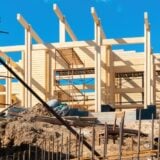The usual states in the US continue to lead foreclosures but in a worrying move other cities so far sheltered from distressed property are creeping up the list, the latest data shows.
California, Florida, Nevada and Arizona, still top the list but in Oregon, Washington and Idaho rates are increasing, the yearend figures from Realty Trac indicate.
The good news is that in the top 10 worst affected locations the rate of foreclosure activity is showing signs of slowing.
For 2009, nine of the top 20 metro foreclosure rates were in California. More than 10% of housing units in Mercedes, California, received a foreclosure filing in 2009, making it the third highest rate in the country. In 2008, Stockton, California had the highest foreclosure rate, but it is now down to 8.62%.
Florida had eight of the top 20 foreclosure rates in the country. Cape Coral-Fort Myers, Florida had an 11.8% foreclosure rate in 2009, the second highest among all metropolitan areas.
Nevada had two of the top 20 foreclosure rates in the US and a little more than 12% of housing units in Las Vegas received a foreclosure filing in 2009, the most of any other city.
The Phoenix metropolitan area in Arizona took the eighth spot with an 8.03% foreclosure rate.
Outside of these four states, the only city in the top 25 was Boise, Idaho where 4.6% of housing units received a foreclosure filing. Foreclosures in such areas, outside the sand states, are inching up, RealtyTrac found. A lot of Oregon cities and Seattle, Washington, places that were insulated from high foreclosure rates, posted higher numbers, but these are more related to unemployment, the report said.
Places like Provo, Utah, Fayetteville, Arkansas, Portland, Oregon and Rockford, Illinois, all posted foreclosure rates above the US average in 2009. And markets like Honolulu, Minneapolis and Seattle saw foreclosure activity increase at more than twice the national pace.
Daren Blomquist, marketing communications manager for RealtyTrac, pointed out that the report does not included foreclosure rates for the fourth quarter for the top 10 metro areas. ‘Many of these saw a decrease in foreclosure activity. It’s a sign that some of the government programmes are making a dent in the numbers,’ he said.
Declines in house prices mixed with increases in foreclosures are not showing a hugely negative knock-on impact for the nation’s overall economic recovery, according to the latest report by FTN Financial, a portfolio manager and analytics provider for the investment and banking industry.
‘Local housing prices and poor credit by themselves do not solely determine participation in the recovery so far. While housing contributed to the downturn, it is not an absolute roadblock to recovery,’ said Jim Vogel, a financial analyst at FTN. But he added that the extent of the decline in the housing and mortgage markets from 2007 to 2009 calls into question the speed and sustainability of the current recovery.
US cities so far untouched by foreclosure crisis now seeing increase
- Share this
- Share on Facebook
- Share on Twitter
- Share on LinkeIn





